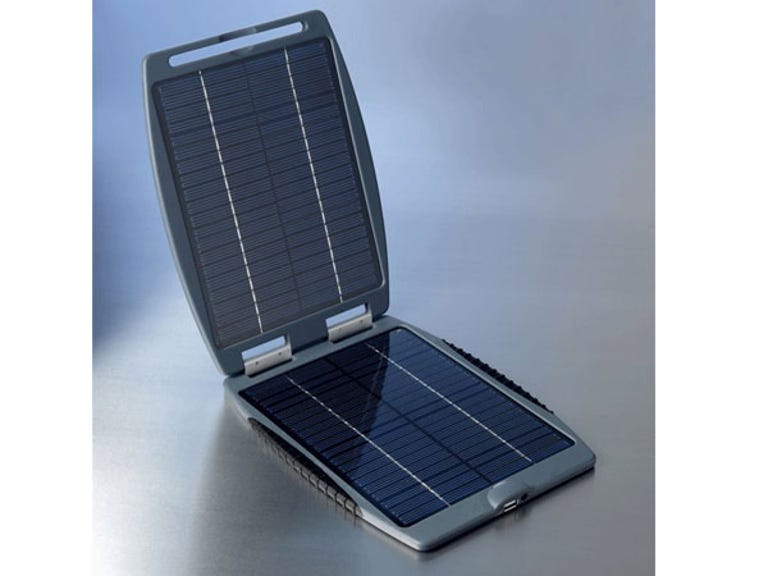 Why You Can Trust CNET
Why You Can Trust CNET Powertraveller solargorilla review: Powertraveller solargorilla
Outdoor types and those who want fuzzy warm green feelings will love the powergorilla and solargorilla, as long as they can bear the price.
Note: this solargorilla was reviewed in conjunction with its companion product the powergorilla.
The Good
The Bad
The Bottom Line
Design
The powergorilla is a big, flat black battery pack with a simple LED display to show power status, and a button that doubles as an on/off switch and power level selector. Its inputs are likewise minimalist, with power in and out plugs flanking a USB socket. Power to charge the powergorilla can come either from direct AC connection, or optionally by purchasing Powertraveller's solargorilla. We've reviewed both here together as they make a lot more sense when used in tandem — something we'll get to shortly.
The powergorilla resembles the solar panel that Powertraveller used on the recently reviewed Powermonkey eXplorer, only on steroids, and in only one colour — a rather utilitarian grey. Like the powergorilla, there are two power outputs, with a choice of a regular plug for the powergorilla and other notebook style devices, and a USB port for charging portable mobile devices such as phones and some game systems.
Along with both the powergorilla and solargorilla, you get a variety of plugs to suit a large number of devices. The smaller tips are called "chimp nuts", while the larger ones are "gorilla nuts", and there's an easy way to differentiate them. As we noted in our review of the Powermonkey eXplorer, the chimp nuts are lightweight and feel rather flimsy. The gorilla nuts that you get with the powergorilla and solargorilla are conversely pretty solid little numbers that also benefit from being labelled. This is quite useful, as the nuts come in plastic trays that very easily pop open and spill everywhere, and getting them identified properly can be something of a nightmare. You do get the same set of Gorilla Nut tips with the solargorilla and powergorilla, so if you buy both you'll end up with some doubles.
Features
Not unsurprisingly, charging is the name of the game for the powergorilla and solargorilla. As with the previously reviewed Powermonkey eXplorer, the idea is that you charge up the powergorilla, either from AC or solar sources, then take it with you to extend the battery life of your mobile gadgetry and laptop PC.
Performance
We charged up the powergorilla from AC first, to get an idea of its compatibility with a small suite of laptops. The powergorilla unit itself feels robust, and it's very easy to sort out the compatible adapter and correct voltage, at which point most of our test laptops got to charging. The one exception to this rule was an Apple MacBook. Powertraveller does sell a solution for Apple users, but it's complicated — you've got to buy the Apple Airline travel adapter, and then plug that in to a Powertraveller cigarette lighter adapter — and then finally into the powergorilla. The local distributor for Powertraveller products wasn't able to source the lighter adapter for our testing, so our MacBook went power-hungry during our testing.
In terms of being a flexible battery pack the powergorilla scored well with us, but at a pretty hefty asking price. One cent short of $375 isn't exactly cheap, and you'd need to make sure that you had a very definite need of all that extra power on a regular basis to make it a worthwhile purchase, especially if your notebook of choice has a larger battery pack option itself.
Then there's the solargorilla. Here our results were a little more mixed. It's clear that Powertraveller sells the unit primarily as a charging mechanism for the powergorilla pack, and in that scenario it performed quite well. Over a day's full charging in direct sunlight, we managed to get slightly more than a half-charge onto the powergorilla, which is more than enough to keep a notebook going for a couple more hours depending on usage. The packaging for the solargorilla also notes that you can charge laptops and mobile phones with it, and that's via the USB port and then the appropriate chimp or gorilla nut of choice.
On the mobile front, the solargorilla performed well. We were able to get a Nokia XpressMusic 5800 charging quickly, and likewise an iPhone 3GS picked up some power, but very slowly. Using it with an already flat iPhone 3G we were unable to muster up enough charge to get the phone operational.
Charging notebooks directly from the solargorilla didn't work for us at all. We tested with a Dell Inspiron 6000, an MSI Wind U100 and an Asus Eee PC 701, and the only one of those we could get to charge — not even run and charge — was the 701, where we managed a weak flicker of the battery light when directly connected. That's not entirely surprising, as the panel isn't likely to deliver the consistent current that most notebooks require for proper charging. It's worth keeping in mind, however, that for notebook purposes you're much better off considering the solargorilla as an accessory to the powergorilla, and not much more.
There's some obvious outdoor scenarios where the powergorilla/solargorilla combo could work quite well, and we've got to admit they do tickle our gadget lust in just the right areas — but at a solid asking price. If you were just thinking about them from a purely environmental perspective, you'd have to bear in mind that the full charge of the powergorilla isn't enough to keep a notebook running all day long, so you'd almost certainly have to run from AC power at some point. Equally, the high cost of initial outlay means it'd be a very long time indeed (if ever) before the use of solar started to make financial sense.


